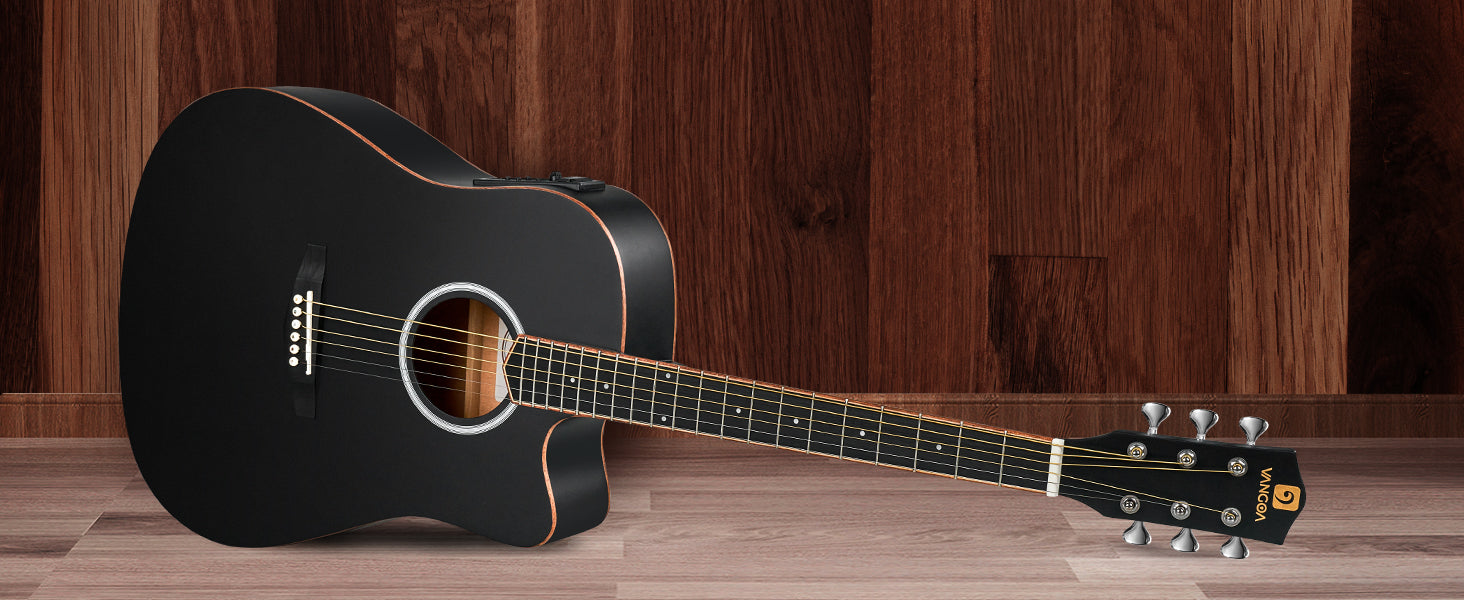Daily maintenance mainly includes:
1. Temperature and humidity control
2. Guitar cleaning and maintenance
3. String replacement
4. Neck curvature inspection and adjustment

First, temperature and humidity control is a key aspect of guitar maintenance. This refers to the temperature and humidity of the environment in which the guitar is placed. Since guitars are made of wood, temperature and humidity directly affect the condition of the wood.
For example, in dry winter conditions, if the guitar is placed in an environment with low humidity for a long time, it may cause the top to warp or crack, cracks in the back and sides, fingerboard cracking, and fingerboard shrinkage that may lead to frets protruding and causing sharp edges. Deformation can also lead to fret buzz and other issues.
During the rainy season or in coastal areas where humidity is too high, the guitar may become damp, causing the top to bulge, neck deformation, increased string height, mildew spots inside the body, and quick oxidation and rusting of the strings and frets. Even if you replace the strings, the sound may still be muffled, so controlling the environment is essential.
The ideal humidity range is between 40% and 60%, with 50% being the best. If the humidity drops below this range, you need to add moisture; if it rises above, you need to dehumidify. A hygrometer can be used to measure the humidity.
Humidification:
There are several methods to add moisture. You can use a guitar soundhole humidifier and place the guitar back in its case or gig bag after playing. When using a soundhole humidifier, be careful not to add too much water, as it may affect the guitar's resonance. Alternatively, you can use a larger household humidifier to increase the humidity in the environment.

If you don't want to spend money on equipment, you can also humidify the environment by mopping the floor with a wet mop, placing a bowl of water next to the guitar, or leaving the guitar in a bathroom with a shower. In any case, you need to maintain an appropriate level of humidity.
Dehumidification:
To reduce humidity, you can place two packets of desiccant inside the guitar case or gig bag and replace them regularly. Alternatively, you can use a household dehumidifier.
For temperature control, simply store the guitar in a temperature range that feels comfortable to humans. Avoid exposing it to direct sunlight on balconies, leaving it in a car under the sun, or placing it under direct air-conditioning or heating. Do not place the guitar directly on heated floors or next to radiators.
So, it is important to adjust humidity and temperature according to the actual conditions in your area.
Second, Guitar Cleaning and Maintenance
After each session, it’s recommended to use a dry cloth to wipe off any sweat from the strings, fingerboard, and frets to slow down the oxidation and rusting of the strings and frets. Additionally, after a period of use, the guitar also requires regular cleaning, such as the areas where the body contacts the elbow or frequently used positions on the fingerboard, which may accumulate sweat and oil. Therefore, it’s important to clean the guitar periodically, especially when changing strings, and don’t forget to clean the fingerboard as well. There are specialized cleaning liquids for guitars, typically divided into body cleaning liquids and fingerboard cleaning liquids, so be sure to check the applicable scope when purchasing and avoid mixing them.
Some fingerboard cleaning liquids contain ingredients like alcohol and acetone, which may affect the finish of higher-quality guitars that use nitrocellulose lacquer.

For cleaning the fingerboard, it’s difficult to get into the gaps between the frets, so you can use a soft-bristled toothbrush to clean them. Be sure to use a soft brush to avoid scratching the fingerboard. When cleaning the fingerboard, if the frets are rusted, simply rub them with a cloth repeatedly until the rust is gone.
It’s not recommended to frequently use a rust-removal polishing machine, as each polishing session wears down the frets. Over time, this may cause the frets to become uneven.
After cleaning the fingerboard, you can treat it with lemon oil, especially in areas with low humidity. Applying oil can restore the fingerboard's luster and balance the oils, preventing it from drying out and cracking. When applying oil, spread it on the fingerboard, let it sit for a few minutes to allow the oil to be absorbed, then wipe off any excess with a dry cloth. For fingerboards made of techwood, maple, or those with closed finishes, there’s no need for oil treatment since they won’t absorb the oil and it could damage the finish, discolor the board, and affect its appearance.
Third, String Replacement Method: For step-by-step instructions, please refer to our article, '7 Steps to Changing Guitar Strings.'
https://www.vangoa.com/blogs/news/7-steps-to-changing-guitar-strings

However, it’s important to note that if the guitar is left unused for a long period, you should loosen the strings. Do not keep the guitar in standard tuning for extended periods, as the tension from the strings could cause the neck to warp or bend. If the guitar is idle for more than a week, it’s recommended to loosen the strings by a whole tone.
Finally, when checking and adjusting the neck curvature, ensure the neck remains straight, neither convex nor concave.
Fourth, How to Determine the Neck Curvature and How to Adjust It?
To determine the curvature of the neck, you can follow these steps:
1. Visual Inspection
- First, visually examine the neck for any noticeable bends or twists. Stand directly in front of the guitar (or other stringed instruments) and check if the neck is symmetrical.
2. Use a Straightedge or Ruler
- Place a straightedge along the length of the neck to check if it makes contact with the neck surface. If the neck is bent, the ends of the straightedge will be at different heights from the neck’s surface. You can check various parts of the neck, especially the middle section.
3. Observe String Height in Relation to the Neck
- Press down the first and last frets of the strings, then observe the gap between the strings and the neck in the middle. If the string height is abnormal, it indicates that the neck might be curved.
4. Sound Quality Check
- When playing each string, if you notice any unclear tones, buzzing, or "string-on-fret" noises, it could be caused by a bent neck.
Precautions:
- When adjusting the neck, it’s best to do so when the string tension is moderate. Strings that are too tight or too loose may affect the adjustment results.
- Be cautious when adjusting; excessive turning of the truss rod could damage the neck.
If you're unsure or the adjustment results are unsatisfactory, seek assistance from a professional instrument technician.




Share:
Vangoa Violins Crafting Quality Sound for Aspiring and Professional Musicians